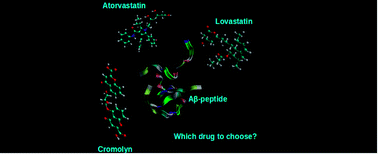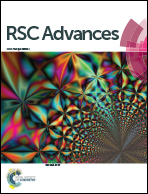Two statins and cromolyn as possible drugs against the cytotoxicity of Aβ(31–35) and Aβ(25–35) peptides: a comparative study by advanced computer simulation methods†
Abstract
In this work, possible effective mechanisms of cromolyn, atorvastatin and lovastatin on the cytotoxicity of Aβ(31–35) and Aβ(25–35) peptides were investigated by classical molecular dynamics and well-tempered metadynamics simulations. The results demonstrate that all the drugs affect the behavior of the peptides, such as their ability to aggregate, and alter their secondary structures and their affinity to a particular drug. Our findings from the computed properties suggest that the best drug candidate is lovastatin. This medicine inhibits peptide aggregation, adsorbs the peptides on the surface of the drug clusters, changes the secondary structure and binds to MET35, which has been seen as the reason for the toxicity of the studied peptide sequences. Moreover, lovastatin is the drug which previously has demonstrated the strongest ability to penetrate the blood–brain barrier and makes lovastatin the most promising medicine among the three investigated drugs. Atorvastatin is also seen as a potential candidate if its penetration through the blood–brain barrier could be improved. Otherwise, its properties are even better than the ones demonstrated by lovastatin. Cromolyn appears to be less interesting as an anti-aggregant from the computational data, in comparison to the two statins.



 Please wait while we load your content...
Please wait while we load your content...